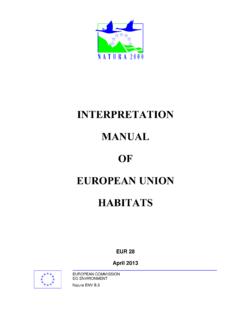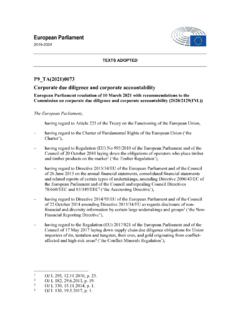Transcription of RULES & REGULATIONS ON ELECTRIC CYCLES IN …
1 1 RULES & REGULATIONS ON ELECTRIC CYCLES IN european UNIONI ncluding type approval, CEN standards, EU Directives, Terms of UseWhite Paper2 UPDATED WHITE PAPER ON ALL ELECTRIC BICYCLE RULES AND LEGISLATIONAs a follow-up on the first edition published by Bike Europe a few years ago, this White Paper offers an updated and detailed overview of all RULES and REGULATIONS governing ELECTRIC of the major changes concerns the technical REGULATIONS resulting from the new type-approval, which has become definitely effective in January 2017. All ELECTRIC bikes, except those with assistance up to 25 km/h and a maximum continuous rated power of 250W, must comply with the european harmonised technical RULES laid down in type-approval legislation. 2016 was a transition year during which manufacturers could choose between type-approval according to Directive 2002/24 or according to Regulation 168/ 2013 . Since January 2017, all new ELECTRIC bikes subject to type-approval must comply with the RULES laid down in Regulation 168/ 2013 and its delegated and implementing acts, before they can be distributed on the european bikes approved according to the 2002-system may still be made available on the market, registered or entered into service until 31 December new Bike Europe White Paper contains all details on type approval Regulation 168/ 2013 , including full details on the categorization of different types of ELECTRIC bicycles.
2 Furthermore, the White Paper has full updated details on RULES and legislation governing ELECTRIC bicycles with 250W and assistance up to 25 Paper: RULES and REGULATIONS on ELECTRIC CYCLES in the EURules & REGULATIONS on ELECTRIC CYCLES in european UnionPhoto TrekStay on top of the news and sign up for Bike Europe s free email newsletter at a week you will receive an overview of the latest updates on laws & REGULATIONS , directly into your OF CONTENTSPART 1: Technical RULES specifically for ELECTRIC CYCLES : type-approval and CEN-standards1. Type-approval a. Type-approval scopeb. Type-approval categorizationc. Type-approval requirements for ELECTRIC cyclesd. Type-approval factor foure. Type-approval legal textsf. Type-approval procedures2. CEN standards: EN 15194, EN 14764, ISO 4210 and EN 50604a. EN 15194b. EN 14764 and ISO 4210c. EN 50604 PART 2: Other legislation applicable to ELECTRIC cycles1.
3 General Product Safety Directive2. Machinery Directive3. Electromagnetic Compatibility Directive4. RoHS Directive5. Low Voltage Directive6. Battery Directive7. WEEE Directive8. REACHPART 3: Battery transportationPA RT 4 : Terms of use for ELECTRIC cycles1. Helmet obligations2. Number plates3. Insurance4. Traffic code5. Driving licence and age limits6. Fiscal/financial incentivesRules & REGULATIONS on ELECTRIC CYCLES in european UnionPhoto Cube4PA R T 1 : TECHNICAL RULES SPECIFICALLY FOR ELECTRIC CYCLES : TYPE-APPROVAL AND CEN-STANDARDS1. TYPE-APPROVALA. TYPE-APPROVAL SCOPEFor clarity, in the following text pedelec means a bicycle with a motor that only functions on condition the cyclist pedals, whilst e-bike means a bicycle that can be propelled by the motor itself irrespective of the cyclist pedalling. The term ELECTRIC (bi) cycle is generic and includes pedelecs, e-bikes and combinations of these principle, all ELECTRIC CYCLES with two, three or four wheels come under the type-approval as set out in Regulation 168/ 2013 , the three supplementing, technical REGULATIONS and the implementing, administrative Regulation.
4 However, article 2 of Regulation 168/ 2013 excludes the following categories of ELECTRIC CYCLES from type-approval:(d) vehicles exclusively intended for use in competition; (g) vehicles primarily intended for off-road use and designed to travel on unpaved surfaces;(h) pedal CYCLES with pedal assistance which are equipped with an auxiliary ELECTRIC motor having a maximum continuous rated power of less than or equal to 250 W, where the output of the motor is cut off when the cyclist stops pedalling and is otherwise progressively reduced and finally cut off before the vehicle speed reaches 25 km/h(k) vehicles equipped with any seating position of the driver or rider having an R-point height 540 mm in case of categories L1e, L3e and L4e or 400 mm in case of categories L2e, L5e, L6e and mountain bikes are not in the Haibike5 Because of the above, ELECTRIC bikes used for competition, ELECTRIC mountain bikes, pedelecs 25 km/h 250 W and ELECTRIC recumbent CYCLES with a seat height below the specified limits are not in the type-approval.
5 Furthermore, article 2 excludes self-balancing vehicles and vehicles without a seating position. This exclusion paved the way for CEN, the european standardization institute, to start up the development of a european standard for these two vehicle types. Consequently, working group 4 of CEN/TC 354 Light ELECTRIC vehicles and self-balancing vehicles is currently developing such a TYPE-APPROVAL CATEGORIZATIONFor the type-approval, Regulation 168/ 2013 classifies the vehicles in 7 different categories. Depending on their speed limit, power limit and number of wheels, ELECTRIC CYCLES come under 4 different categories as detailed in the table TYPE-APPROVAL REQUIREMENTS FOR ELECTRIC CYCLESL1e-A powered CYCLES is a new category, which has been introduced into type-approval through Regulation 168/ 2013 . The category L1e-A did not exist in the type-approval following Directive 2002/24. It has been set up to accommodate ELECTRIC CYCLES , both pedelecs and e-bikes, with a speed limit of 25 km/h and a power limit that exceeds 250W with a maximum of 1kW.
6 The other three categories did exist in the previous system and were originally set up for conventional mopeds and motorcycles. Consequently, the technical requirements for these categories were not adapted to ELECTRIC CYCLES . A number of stakeholders, such as ETRA, AVERE and CONEBI L-categoryTechnical specificationsNumber of wheelsL1e-A powered CYCLES Max. power: > 250 W < 1 kWMax. speed: 25 km/hPedal assistance + Motor only2, 3 and 4 wheelsL1e-B mopeds Max. power: < 4kWMax. speed: 45 km/hPedal assistance + Motor only2 wheelsL2e three-wheel moped Max. power: < 4kWMax. speed: 45 km/hPedal assistance + Motor onlyMax. mass: <270 kgMax. 2 seats3 wheelsL6e light quadricycle Max. speed: 45 km/hPedal assistance + Motor onlyMax. mass: <450 kgMax. 2 seats4 wheelsRules & REGULATIONS on ELECTRIC CYCLES in european Union6negotiated with the Commission on adapted technical requirements for ELECTRIC CYCLES in the L1e-A and B categories.
7 The system is not perfect yet, so in the next couple of years, further updating and improving will be required. The table below lists all requirements from which ELECTRIC CYCLES are excluded, as well as those requirements which have been adapted to better suit ELECTRIC CYCLES . If components and characteristics are not in the table, it means that ELECTRIC CYCLES have been excluded from type-approval for TYPE-APPROVAL REQUIREMENTS FOR ELECTRIC BICYCLESR egulationComponent/characteristicVehicle typeRequirements and testsRVFSR Annex IIAudible warning devicesL1e-AExcludedRVFSR - Annex IIAudible warning devicesL1e-BElectrical device approved following UNECE Reg. No 28 RVFSR - Annex IIIB rakingL1e-A & BRequirements of UNECE Reg. 78 but if mass in running order is < 35 kg, then 2 exceptions:In hydraulic brakes, reserve fluid receptacles excluded from ease of fluid-level checking requirementsAdapted testing requirements for rim brakesAdapted stopping distance requirements for vehicles with rim widths of < 45 Annex IVElectrical safetyL1e-A & BRequirements detailed in the RegulationRVFSR Annex VEndurance testingL1e-ARequirements detailed in the Regulation: definition of normal use: 5 years and a total distance travelled of 7,500 kmRVFSR Annex VEndurance testingL1e-BRequirements detailed in the Regulation: definition of normal use: 5 years and a total distance travelled of 16,500 kmRVFSR- Annex VIIID river-operated controlsL1e-AExcludedRVFSR Annex VIIID river-operated controlsL1e-BRequirements in UNECE Reg.
8 No 60 except lever requirements in Annex 3 + certain requirements in the Regulation7 RVFSR Annex IXLighting and light signalling devicesL1e-AWhite headlamp, red rear light, amber side reflectors, amber pedal reflectors and a red rear reflector. Type-approval not required but manufacturer must declare conformity with ISO 6742-1:1987 and 6742-2:1985. Retro-reflective bands on tyre sidewalls or rims are allowed. Activated instead of automatically switched-on headlamps are Annex IXLighting and light signalling devicesL1e-BRequirements in UNECE Reg. No 74 + certain requirements in the may be fitted with additional rear and side reflective registration plate lamp instead of automatically switched-on headlamps are Annex XRearward visibilityL1e-AExcludedRVFSR Annex XRearward visibilityL1e-BClass II or III devices type-approved according to UNECE Reg. No 46 RVFSR Annex XIIIS eating position L1e-A & BVehicles must be fitted with one saddle facing forward, no type-approval requiredRVFSR XIVS teerability, cornering properties & turnabilityL1e-A & BLimited requirements in the Regulation RVFSR Annex XVTyresL1e A & BVehicles with a technically permissible maximum mass 150 kg may be fitted with non-type-approved tyres with a section width 67 Annex XVIIIM aximum continuous rated and/or vehicle speed limitation by designL1e-A & BSpecific anti-tampering requirements for ELECTRIC motors in the RegulationRVFSR Annex XIXV ehicle structure integrityL1e-A & BRequirements in the Regulation + vehicles L1e-A and CYCLES designed to pedal in L1e-B must conform with ISO 4210:2014.
9 Definition of CYCLES designed to pedal in Annex XIX: pedelecs up to 45 km/h + factor 4 RVCR Annex IIAnti-tampering measuresL1e-A & BRequirements in the RegulationRVCR Annex IIIA rrangements for type-approval proceduresL1e-A & BRequirements in the RegulationRVCR Annex IIIC onformity of productionL1e-A & BRequirements in the RegulationRVCR Annex VDevices to prevent unauthorised useL1e-A & BExcluded8 RVCR Annex VIElectromagnetic compatibilityL1e-A & BRequirements of UNECE Reg. No 10 RVCR Annex VIIE xternal projectionsL1e-A & BRequirements in the RegulationRVCR Annex XIMasses and dimensionsL1e-A & BRequirements in the RegulationRVCR Annex XIIIP assenger handholds and footrestsL1e-AExcludedRVCR Annex XIIIP assenger handholds and footrestsL1e-BHandholds not required if the vehicle is not designed to carry passengers. Pedals are considered to meet the footrests requirementsRVCR Annex XIVR egistration plate spaceL1e-A & BRequirements in the Regulation: min.
10 10 cm wide and cm highRVCR Annex XVRepair and maintenance informationL1e-A & BRequirements in the RegulationRVCR Annex XVIS tandsL1e-A & BRequirements in the RegulationREPPR Annex XPropulsion Unit performanceL1e-AMaximum speed testing requirements in Annex X but vehicles with pedal assistance tested according point in EN 15194:2009. Torque and power testing following UNECE Reg. No 85. Requirements for measuring continuous rated power, switch-off distance and maximum assistance factor in Appendix 4 of Annex XREPPR Annex XPropulsion Unit performanceL1e-BMaximum speed, maximum torque and maximum continuous rated testing requirements in Annex X but bicycles with pedal assistance tested according to point in EN 15194:2009. Torque and power testing following UNECE Reg. No 85. Requirements for measuring continuous rated power, switch-off distance and maximum assistance factor in Appendix 4 of Annex XREPPR Annex XIIM easurement of ELECTRIC energy consumption and of ELECTRIC rangeL1e-A & BExcluded from ELECTRIC range measurement.



